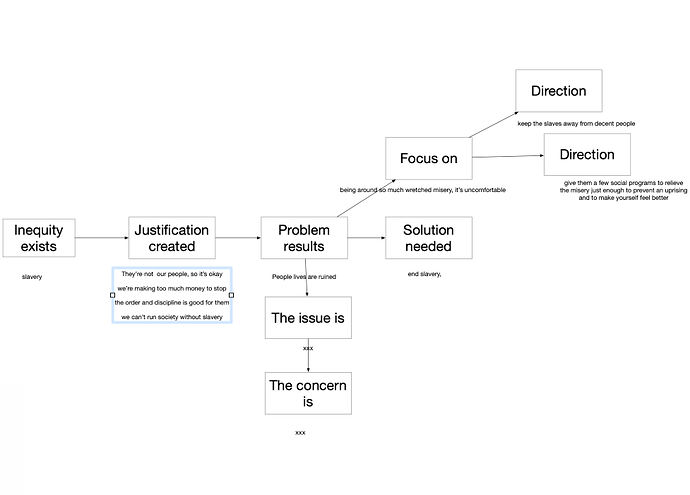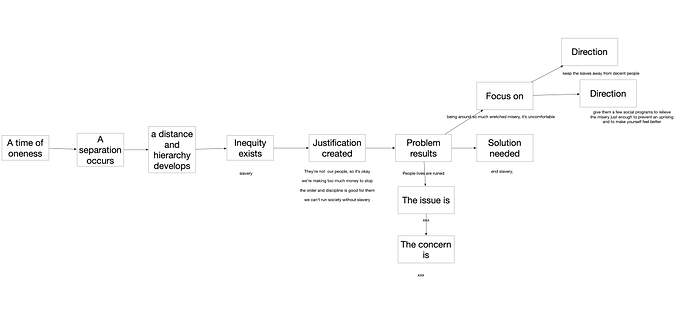Why do you want to know the meaning of the inequity?
Blink, Blink Uh, I wasn’t trying to ask about the meaning of the inequity, just how you go about using dramatica to determine what the inequity might be. That’s what a story is, right, an exploration of the inequity? How can you write a story if you don’t know what the inequity is?
Hi Diane, once you turn all those story point gists into a story (or the outline for a story, I mean breathe life into them and tie them together) wouldn’t it be easier to understand the inequity then?
I’m still not sure that you need to know the inequity to start writing, but maybe that depends on the writer.
EDIT: I think once you have the story points illustrated and tied together, the inequity technically shows up in everything because it’s the reason for having a story, but it’s most obvious in Domain, Concern, Issue, and Problem (of all the throughlines, but most objectively in OS). But to paraphrase Jim, none of those are the inequity, they are the effects of the inequity. There is some good info here if you haven’t seen it: within-the-context-of-story-structure-what-is-an-inequity
(Take my comments with a grain of salt as I’m nowhere near as experienced as Jim, or you!)
You can’t describe the inequity so why would you want to try and imagine it?
If you could describe it there would be no need for a story.
- You start with oneness.
- There is separation.
- We look to one and label it a problem.
- Now you have the makings of a story.
3 and 4 are all you really need to worry about.
@jhull This is from your James Bond Article. The first thing you say to do is determine the inequity that starts the story. That’s what I’m talking about. You need to know that.
A Process for DeterminIng Protagonist
The determination of the Protagonist in a story comprises three steps. First, identify the inequity that starts the story. Second, determine the potential solution that will resolve that initial inequity. And lastly, establish the goal of the story.
As mentioned in the series of articles The Story Goal, this established endpoint is universal in that it applies to all the characters involved:
Note that this Goal does not come attached to any one character. No one owns the Goal of a story, rather it attracts and repels everyone within. Some will be for it while others would rather the inequity persist. Some may even be responsible for starting the problem in the first place. Regardless, look not to individual wants and needs for the Goal of a story. Seek the initial inequity and work from there.
The Protagonist–regardless of personal issues–will push towards that Goal, the Antagonist will oppose it.
Ahh ok. I see what you’re referring to now. That inequity is not something you see in the storyform but rather the thing you’re writing about.
So what is the Decision that screws everything up in your story?
I don’t know how many times I have searched the forum now for “inequity” trying to get my head around what an inequity is. Your analogy Jim with the car helped a lot … but I quickly forgot how this all linked together.
As I learn better by visualizing things just want to share a little exercise I did today.
Hope you don’t mind Jim, for the sake of clarity I just used parts of your post and added some picture to visualize the process.
Btw, is there any space or place to share this kind of tools? Over the last years I have developed some tools for myself to understand the theory better … might be worth sharing
Hah! This is great!!
Absolutely, feel free to share whatever you want here in this forum. Eventually, I should probably create a catch-all page or series of pages on Dramatica.com so that others can see what you have there.
Chris Huntley has a similar set of graphics for explaining inequity–graphics that I later adopted for my classes at CalArts and my Weekend Workshops (substituting Lightning McQueen for clipart!).
Btw, you forgot how it all works because your mind doesn’t want you to know how it works. The more you do, the less it can trick you into being motivated, and the more apt you are to climb a mountain in the Himalayas and fall into a deep slumber. 
An inequity is not real–its something made up in our heads. It begins the moment we sense a separateness between I and They, and continues until we’re done (dead). We label inequity with words like Problem and Solution and Issue and Concern so we can somehow observe some greater meaning out of something we’ve created totally in our heads.
Hi everyone,
I’m not sure if this is the right interpretation of inequity, but there are two things I have picked up on from this, and other recent threads:
-
an inequity is when two things can’t coexist at the same time (from a characters perspective - its all in their heads)
-
an inequity motivates conflict
So I was wondering if it was possible to embed these two concepts into an encoding of a Dramatica story point, to improve the quality of that encoding. For example:
Initial idea for encoding: Alice is a single mum worried about being a good parent (concern of playing a role)
This encoding is focussed on storytelling not conflict.
Inequity: For Alice these two things can’t coexist: being a good parent + having her son pick his nose. So a personal conflict arises whenever her son picks his nose, and she is invariably motivated to slap him, which makes the son cry and throw a tantrum, and people look at Alice as if she is doing something wrong, which just makes her more anxious about being a good parent.
In other words, whenever you try to encode a storypoint, you write two sentences:
- For X these two things can’t coexist A +B
- Whenever B occurs, X is motivated to do something that causes conflict
Where B is the thing that X tries to fix, and A is the thing that is never examined, but it is really the existence of A+B (an inequity) that is motivating the conflict.
Once the inequity has been found (or chosen, you can try different ones and pick the best), the clunky sentences can be dropped, and the encoding simplified thus:
Alice is a single mum concerned about being a good parent, who won’t allow her son to pick his nose in public, even though he throws a tantrum whenever she tries to disciplines him for doing this.
This is just something I am experimenting with in my own writing, which I thought might be worth sharing…
I forgot to say that when I do this exercise, I imagine the inequity as something that gives the character a dilemma, putting them between a rock and a hard place, and forcing them to do something…
The only thing I might change is the X — that’s really dependent on the Throughline. So in your example, X could be:
- a single mom (Main Character)
- a strict mother (Influence Character)
- a mother/son relationship (Relationship Story)
- one of several dysfunctional families (Overall Story)
That way you can guarantee the encoding works properly within the function of the Throughline (perspective)
Oh that’s nice. I’ve only been using it with a main character so far…
Would it really be “a strict mother” in this case, if the relationship is between mother and son?
A strict mother could have impact on her son as well as challenge and influence those around her. I admit it’s not as easy to encapsulate into a short phrase, but I thought it sounded right.
I meant more if it’s supposed to be in the same context. If the main character is the single mom, and the relationship is between mother and son, then the influence character is probably not going to be a strict mother, right? Unless the influence of the son makes the mother strict or something.
It’s not supposed to be in the same story…
Would you mind sharing a few more examples if you have some?
Wow.
That’s so good I’m going to try doing this.
Thank you sincerely.


